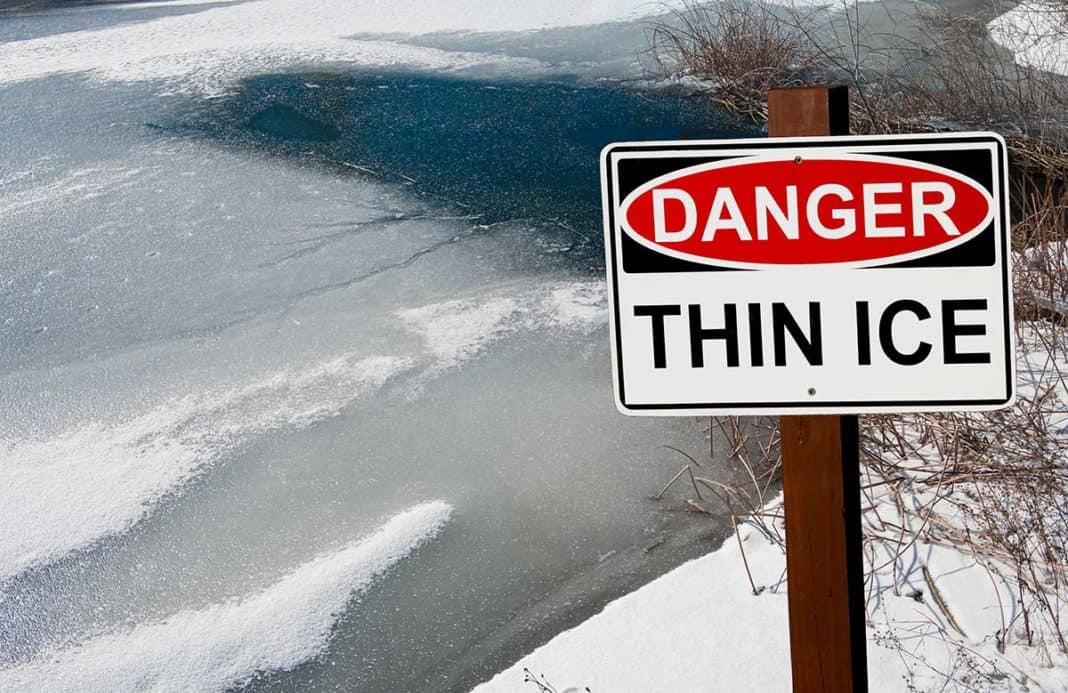MANITOULIN – Several local fire chiefs are in agreement with calls from the Ontario Provincial Police (OPP) for people to stay off the ice as mild weather conditions have meant thin ice, or no ice at all in many cases on lakes and inland waters around Manitoulin Island, pointing out fire departments across the Island do not provide ice rescue except if it is shore-based.
“My fear is that we will be getting a call this winter (of someone going through the ice),” stated Martin Connell, Billings Township fire chief. “We just haven’t had the consistent cold temperatures to have good ice. It’s good to get awareness out there,” he said, noting, “we (Billings) don’t do ice rescues. We don’t have the equipment or training for this.”
“I saw a couple of people ice fishing on Lake Kagawong a couple of weeks ago and I have noticed on Lake Mindemoya all kinds of snowmobile tracks,” said Mr. Connell. He explained in the case of someone going through the ice fire departments must call the police. From there the OPP would call the (US) Coast Guard to try and rescue someone in the water.
Gore Bay Fire Chief Michael Addison told the Recorder “I had a call from Martin (Connell), who saw people out ice fishing. We don’t provide ice rescue, we only provide shore-based rescue, the same as Billings and M’Chigeeng (fire departments) and others on the Island.”
“Regardless of how cold it gets, I don’t think we are going to have great ice on the North Channel this year,” said Mr. Addison. He said even in the case of some inland waters appearing to be frozen over, it’s not good enough ice to be on.
“What gets me is that people take chances, something happens and they expect us as volunteers, or the police or paramedics to rescue them. People need to be responsible and not go out on the ice.”
“As I said to Martin we need to get the word out that no one can come and get you if you go through the ice,” continued Mr. Addison. “Most, if not all, of our fire departments (on Manitoulin) don’t do ice rescues, except for shore-based rescue, where we will try to get a ladder or a rope out to someone who has gone through the ice.”
Mr. Addison pointed out as well, “just because ice is safe to walk on in one place, it may not be 20 feet further.”
John Reid, fire chief for the Municipality of Central Manitoulin said that his fire department only provides shore-based rescue. “All we can do is be on the scene and throw a rope or ladder to someone who has gone through the ice. I haven’t seen anyone out. There was two inches of ice near the docks in Kagawong last Thursday. I know on January 5 someone was jet skiing on Lake Mindemoya.”
“It’s a good idea to put an article in the paper to let people know with all the mild weather we have had people need to stay off the ice,” said Mr. Reid.
Mr. Connell noted as well, “we have had a lot of people move to the Island in the past while. They may be new and not familiar to Manitoulin and think that we provide the same ice rescue services as a place like Toronto with helicopters, hover crafts and other equipment. People may expect the same level of service here on the Island but we can’t afford to provide this.”
Mr. Connell is also a member of North Shore Search and Rescue, “which no longer provides ice rescues. We just don’t have all the equipment needed and we are mandated to do ground-based searches.”
Mr. Connell posted a message on Facebook this past weekend explaining, “there is no ice water rescue here on the Island except for NEMI (Northeastern Manitoulin and the Islands) and it’s shore-based only. By the time the OPP helicopter arrives from Orillia or the US Coast Guard, it will be too late and will very likely be a recovery instead of a rescue. Please keep that in mind before you go out on the ice. Standing from shore and watching is not a fun experience. Trust me, I know first-hand.”
The local firefighters’ concerns align with those of the OPP. The OPP is warning snowmobilers that recent and current mild conditions have not helped with ice conditions and not taking the necessary precautions can quickly result in tragedy.
No ice is safe ice, reports the OPP. Underlying water currents or air pockets can create thin ice, even in the coldest temperatures.





